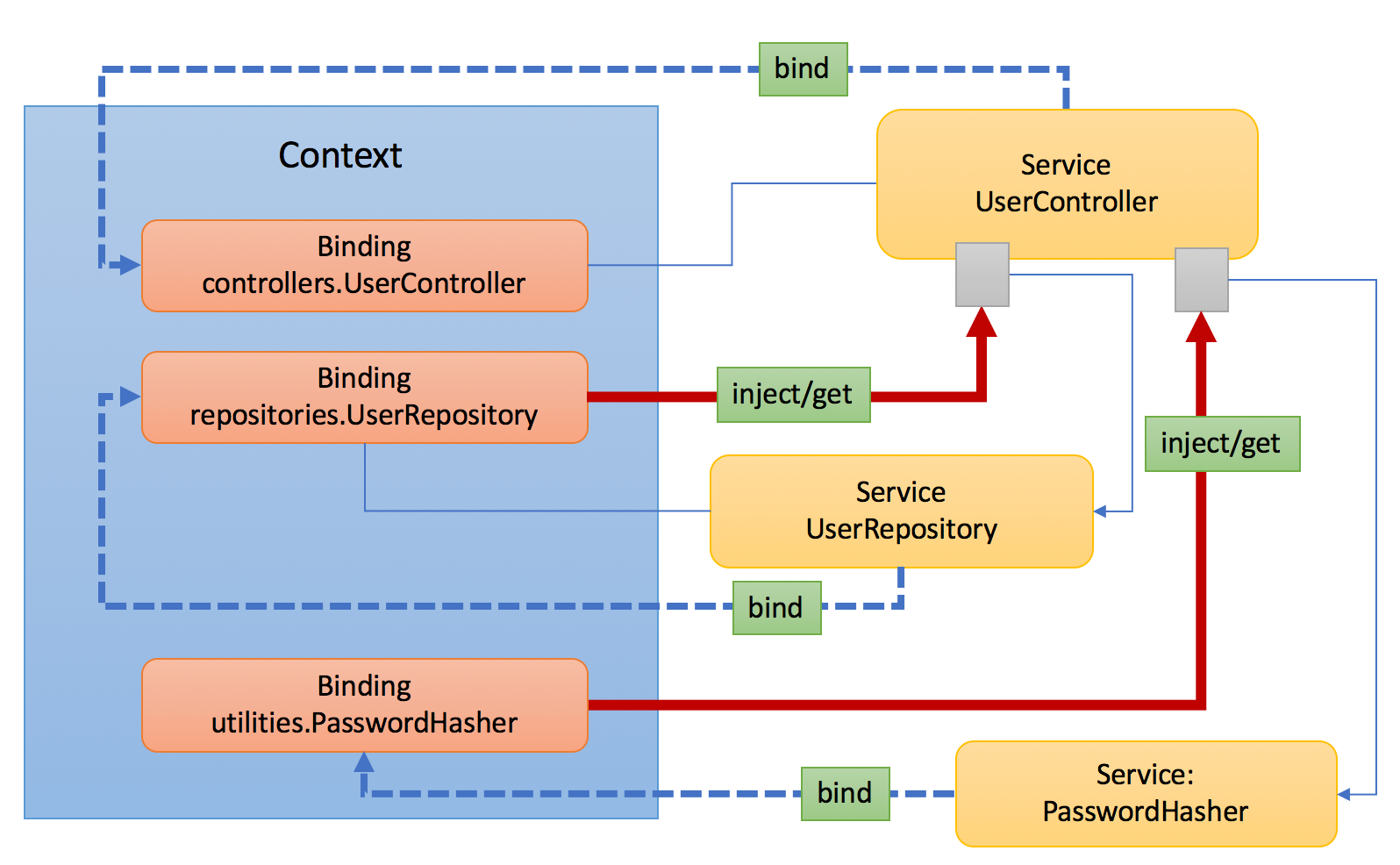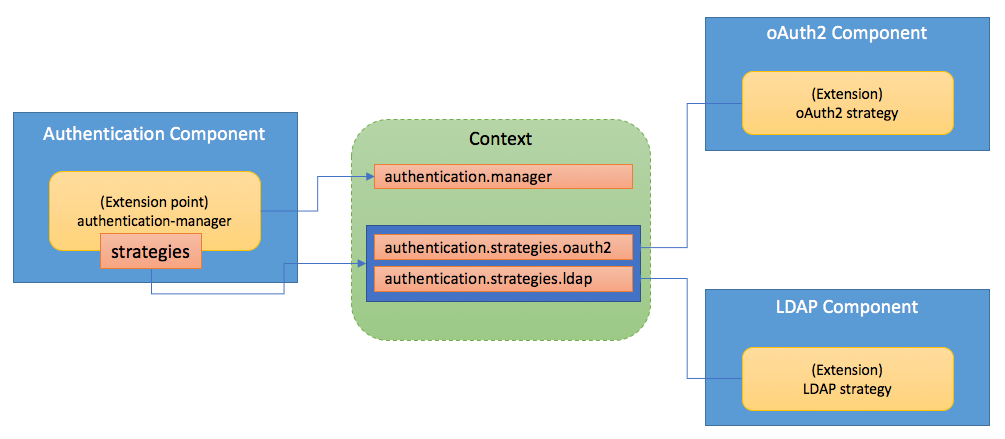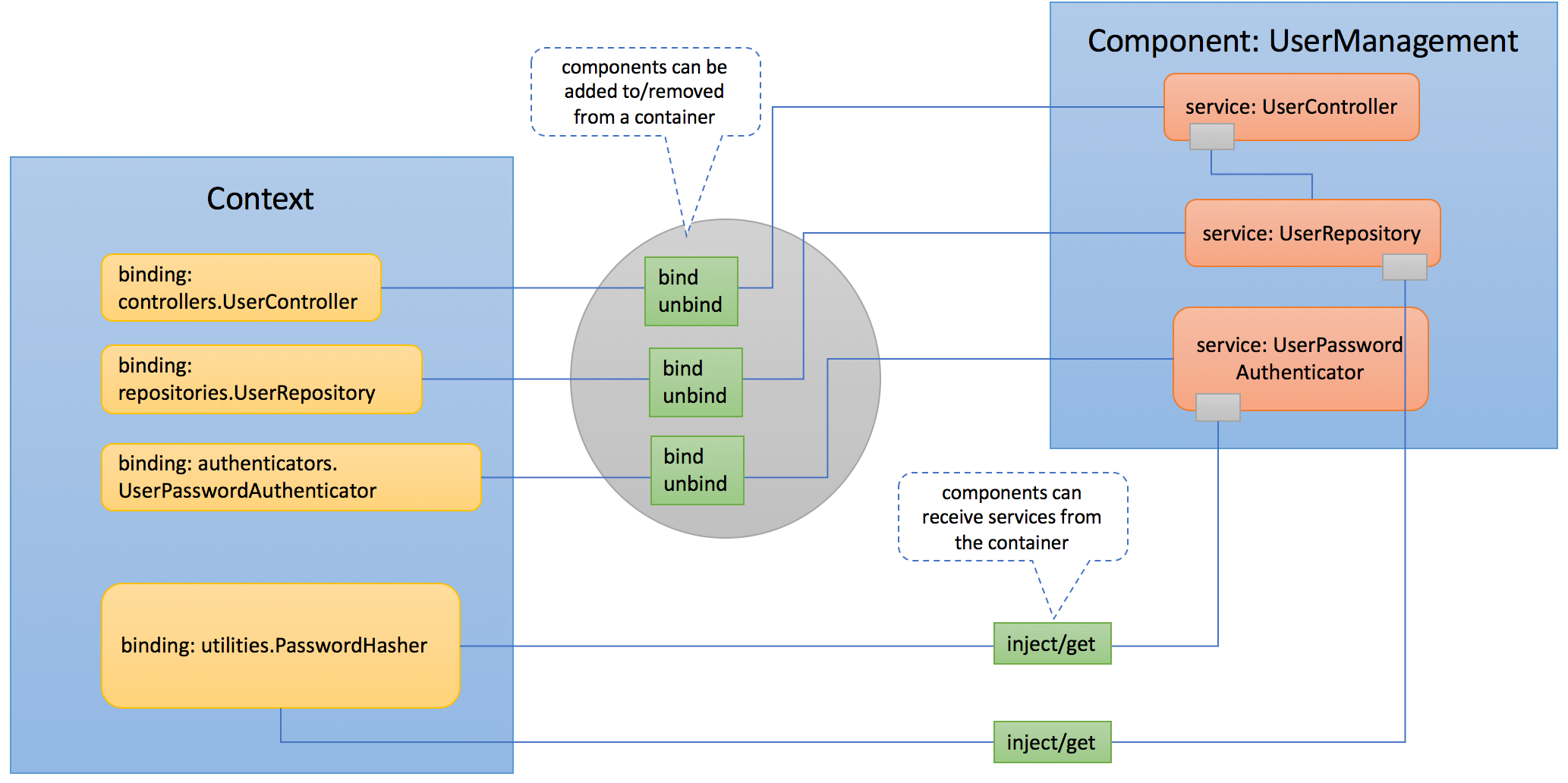Overview
LoopBack 4 is designed to be highly extensible. For architectural rationale and motivation, see Crafting LoopBack 4.
Building blocks for extensibility
The @loopback/context module implements an Inversion of Control (IoC) container called Context as a service registry that supports Dependency injection.
The IoC container decouples service providers and consumers. A service provider can be bound to the context with a key, which can be treated as an address of the service provider.
The diagram below shows how the Context manages services and their dependencies.

In the example above, there are three services in the Context and each of them are bound to a unique key.
- controllers.UserController: A controller to implement user management APIs
- repositories.UserRepository: A repository to provide persistence for user records
- utilities.PasswordHasher: A utility function to hash passwords
Please also note that UserController depends on an instance of
UserRepository and PasswordHasher. Such dependencies are also managed by the
Context to provide composition capability for service instances.
Service consumers can then either locate the provider using the binding key or
declare a dependency using @inject('binding-key-of-a-service-provider') so
that the service provider can be injected into the consumer class. The code
snippet below shows the usage of @inject for dependency injection.
import {inject, Context} from '@loopback/context';
/**
* A UserController implementation that depends on UserRepository and PasswordHasher
*/
class UserController {
// UserRepository and PasswordHasher are injected via the constructor
constructor(
@inject('repositories.UserRepository') private userRepository: UserRepository,
@inject('utilities.PasswordHasher') private passwordHasher: PasswordHasher),
) {}
/**
* Login a user with name and password
*/
async login(userName: string, password: String): boolean {
const hash = this.passwordHasher.hash(password);
const user = await this.userRepository.findById(userName);
return user && user.passwordHash === hash;
}
}
const ctx = new Context();
// Bind repositories.UserRepository to UserRepository class
ctx.bind('repositories.UserRepository').toClass(MySQLUserRepository);
// Bind utilities.PasswordHash to a function
ctx.bind('utilities.PasswordHash').to(PasswordHasher)
// Bind the UserController class as the user management implementation
ctx.bind('controllers.UserController').toClass(UserController);
// Locate the an instance of UserController from the context
const userController: UserController = await ctx.get<UserController>('controller.UserController');
// Run the login()
const ok = await userController.login('John', 'MyPassWord');
Now you might wonder why the IoC container is fundamental to extensibility. Here’s how it’s achieved.
-
An alternative implementation of the service provider can be bound the context to replace the existing one. For example, we can implement different hashing functions for password encryption. The user management system can then receive custom password hashing functions.
-
Services can be organized as extension points and extensions. For example, to allow multiple authentication strategies, the
authenticationcomponent can define an extension point asauthentication-managerand various authentication strategies such as user/password, LDAP, oAuth2 can be contributed to the extension point as extensions. The relation will look like:

To allow a list of extensions to be contributed to LoopBack framework and
applications, we introduce Component as the packaging model to bundle
extensions. A component is either a npm module or a local folder structure that
contains one or more extensions. It’s then exported as a class implementing the
Component interface. For example:
...
import {Component, ProviderMap} from '@loopback/core';
export class UserManagementComponent implements Component {
providers?: ProviderMap;
constructor() {
this.controllers = [UserController];
this.repositories = [UserRepository];
};
}
}
The interaction between the application context and UserManagement component
is illustrated below:

For more information about components, see:
Types of extensions
- Binding providers
- Decorators
- Sequence Actions
- Connectors
- Utility functions
- Controllers
- Repositories
- Models
- Mixins
For a list of candidate extensions, see loopback-next issue #512.
System vs Application extensions
Some extensions are meant to extend the programming model and integration capability of the LoopBack 4 framework. Good examples of such extensions are:
- Binding providers
- Decorators
- Sequence & Actions
- Connectors
- Utility functions
- Mixins (for application)
An application may consist of multiple components for the business logic. For example, an online shopping application typically has the following component:
- UserManagement
- ShoppingCart
- AddressBook
- OrderManagement
An application-level component usually contributes:
- Controllers
- Repositories
- Models
- Mixins (for models)
How to build my own extensions
Learn from existing ones
Create your own extension
You can scaffold a LoopBack 4 extension project using @loopback/cli’s
lb4 extension command.